James Duncan (tailor)
James Duncan of Ratho was a Scottish tailor and landowner who worked for Anne of Denmark in England.[1]

Costume
[edit]Duncan had family connections at Colpy near Culsalmond in Aberdeenshire, in the lands of Henrietta Stewart, a favourite of Anne of Denmark, and her husband George Gordon, 1st Marquess of Huntly, and at the Mote of Errol and Gourdiehill in Perthshire.
After the Union of the Crowns in 1603, Duncan came to England and was appointed a yeoman of the robes and master tailor to Anne of Denmark, the wife of James VI and I. As well as working on the queen's clothes, her robes and "bodies", he supplied costume for her masques, including The Vision of the Twelve Goddesses in January 1604. His work for the masque may have involved selecting garments from the wardrobe of Elizabeth I with the Countess of Suffolk and Audrey Walsingham to be cut up and recycled.[2]
Duncan received £5 yearly as a fee as a yeoman of the wardrobe, and £36 as the master tailor by letters patent. In July 1614 he was given an allowance for livery for life. He was also paid for work and materials supplied to the queen.[3]
Landowner
[edit]Duncan bought land and houses around Edinburgh and in East Lothian. He acquired lands in Monktonhall in 1612 and a servant of another court tailor, Alexander Miller, was a witness to the transaction.[4] He bought the estate of Bonnington and Hillhousefield (in Pilrig and North Leith) from Sir Lewis Craig in 1621.[5] He also acquired lands in Ratho from Thomas Otterburn of Redhall and John Marjoribanks, and was known as "James Duncan of Ratho".[6] His house at Ratho, the Place of Ratho, was called "Marjoribanks", a name and surname supposedly derived from a grant of the Ratho lands to Marjorie Bruce, a daughter of Robert the Bruce.[7]
James Duncan died before 1630, when his properties were in the hands of his heirs, his cousins, James Duncan (died 1641), a son of Gilbert Duncan in "Colpnay" near Culsalmond, and Robert Duncan, a son of Peter Duncan in Gourdhill. Duncan had already transferred his property in Monktonhall, which was within the dower lands of Anne of Denmark in Musselburgh, to his cousin James Duncan in 1620.[8] This James Duncan became the second "James Duncan of Ratho". His son, the third James Duncan of Ratho (died 1646), married Isabella Foulis. They had a daughter, Elizabeth Duncan. Following his death, Isabella, Lady Ratho, married Major William Murray at Ratho in 1648.[9]
References
[edit]- ^ Sarah A. Bendall, Shaping Femininity: Foundation Garments, the Body and Women in Early Modern England (Bloomsbury, 2022), p. 118.
- ^ John Pitcher, 'Samuel Daniel's Masque "The Vision of the Twelve Goddesses": Texts and Payments', Medieval & Renaissance Drama in England, vol. 26 (2013), pp. 17-42 citing TNA LR6/154/9.
- ^ Mary Anne Everett Green, Calendar State Papers Domestic, 1611-1618 (London, 1858), p. 243: National Library of Scotland, MS 2066 (Hawthornden XIV), f.48, list of the queen's gifts by patent.
- ^ John Anderson, Calendar of Laing Charters (Edinburgh, 1899), p. 395 no. 1633
- ^ John Russell, 'Bonnington: Its Lands and Mansions', Book of the Old Edinburgh Club, vol. 19 (Edinburgh, 1933), pp. 152, 157.
- ^ Donald Crawford, Journals of Sir John Lauder of Fountainhall (Edinburgh, SHS, 1900), p. 192
- ^ John Smith, 'Lands and Manor House of Gorgie', Proceedings of the Society of Antiquaries Scotland, 62 (1928), p. 271
- ^ Inquisitionum Ad Capellam Domini Regis, vol. 1 (Edinburgh, 1811), nos. 1019, 1020: John Maitland Thomson, Register of the Great Seal of Scotland, 1634-1651, p. 407 no. 1082: John Anderson, Calendar of Laing Charters (Edinburgh, 1899), pp. 444-5 nos. 1839, 1844 Some older articles make Gilbert Duncan the tailor's father.
- ^ John Anderson, Calendar of Laing Charters (Edinburgh, 1899), p. 613 nos. 2621: Francis J. Grant, Canongate Marriages (Edinburgh: SRS, 1915), p. 179.
